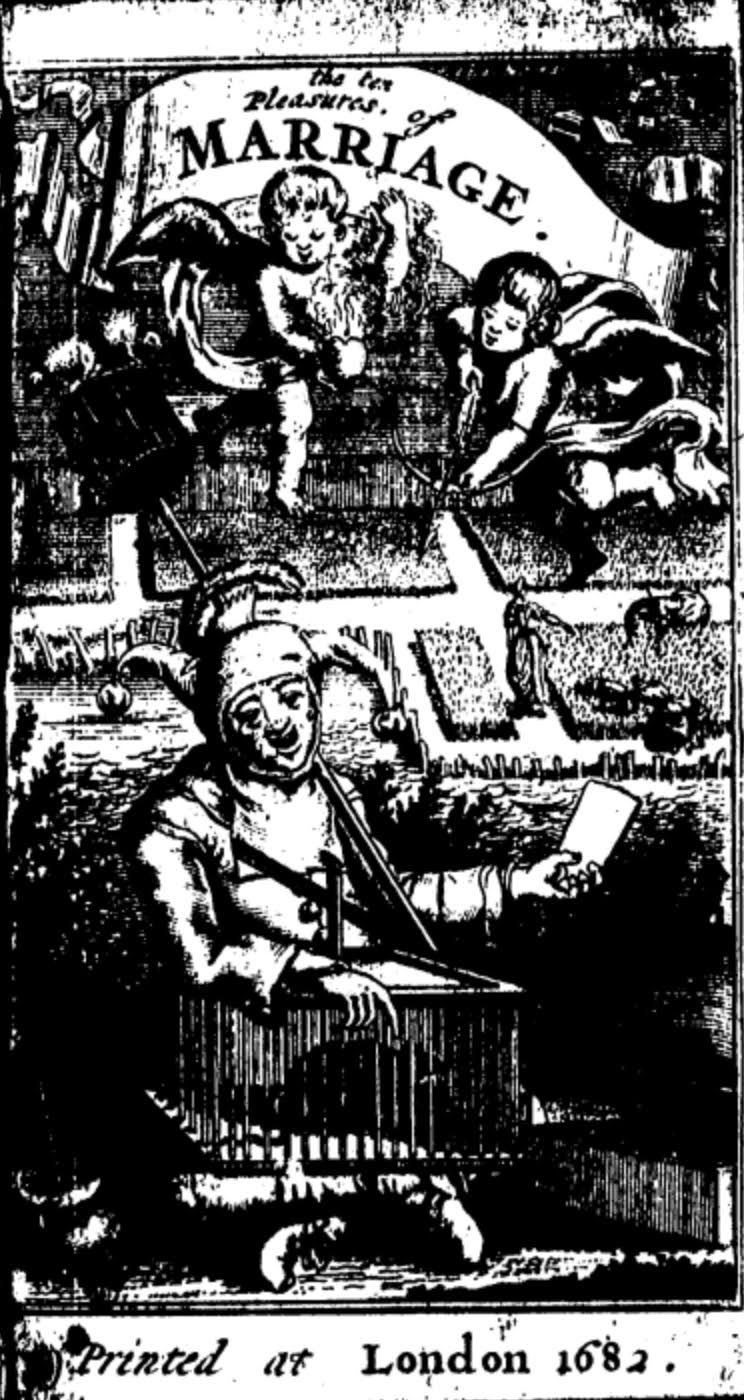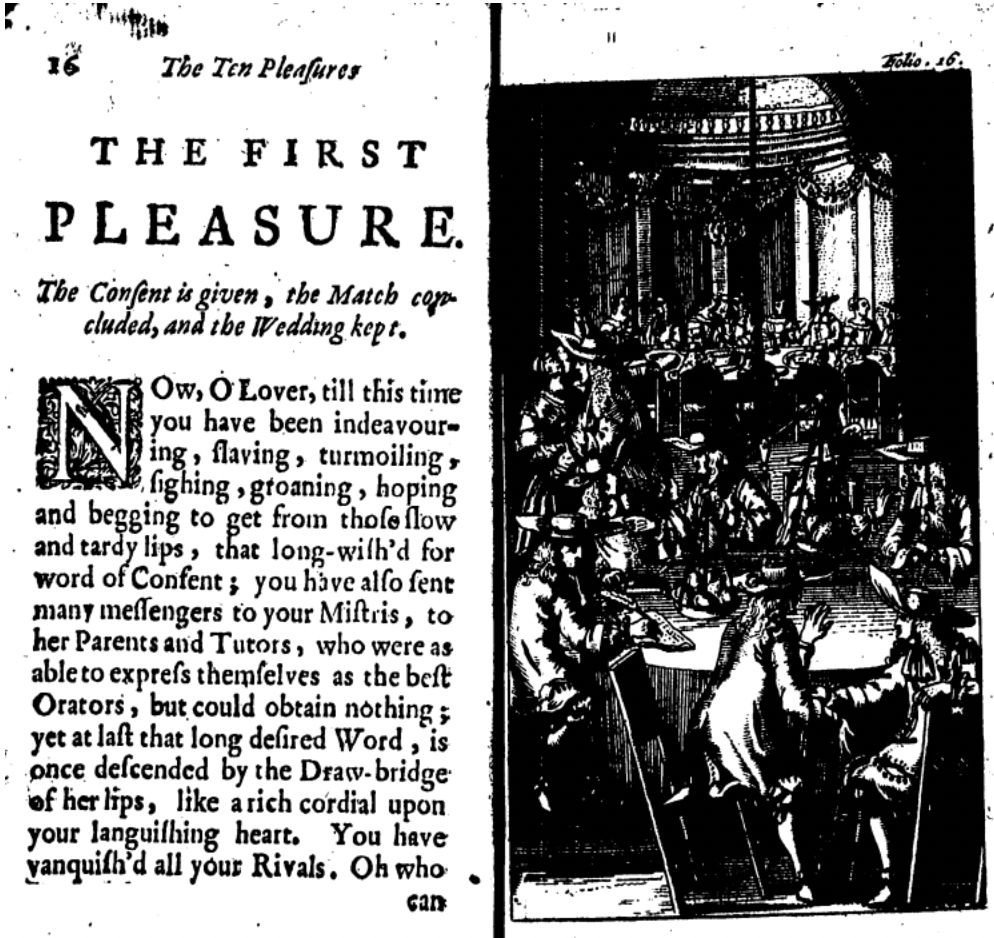The Ten Pleasures of Marriage, relating all the delights and contentments that are mask'd under the bands of matrimony
Overview
"The Ten Pleasures of Marriage, relating all the delights and contentments that are mask'd under the bands of matrimony" is a satirical take on traditional views surrounding marriage in 17th century England. It has now been discovered that it was written by Aphra Bens under the guise of a different name at the time. Bens, often considered the first female playwright in English literature, offers a feisty take on what marriage entails to her readers. This book was published in 1682 in London and now rests in the University of Pennsylvania's rare books collection.
Historical Context
17th Century Europe
The 17th century was a period of significant change and upheaval in Europe. It was marked by major political, social, and cultural transformations that set the stage for the modern era.
One of the most defining events of the 17th century was the Thirty Years' War (1618-1648), which devastated a significant portion of central Europe and left an estimated eight million dead. The war was fought primarily between Catholic and Protestant powers, and followed the pattern of many religious-based wars preceding it.
Another major development of the 17th century was the rise of the nation-state as the dominant political unit in Europe. Through conquest and colonization, monarchs and rulers attempted to consolidate power within their own borders. Because a mercantilist economy was still the primary way of thinking, expanding borders and taking land was viewed as the best way for a country to gain power.
The 17th century also saw significant advances in science and philosophy. Historical figures like Galileo, Descartes, and Newton led Europe in revolutionary ways of understanding the world. They challenged many views, calling into question the accuracy of the Bible and other revered "truths." This era also saw the emergence of new artistic and cultural movements, including Baroque art and music. Entertainment, such as theatre, also gained traction as a popular activity. Further, Europe's social and economic structures became increasingly complex as its population grew and urbanized. These changes laid the groundwork for the industrial revolution and modern capitalism, with thinkers like Adam Smith leading the way. In combination, these advances led Europe into the Enlightenment era.
17th Century England
Similarly to Europe as a whole, 17th century England endured momentous changes.
The English Civil War (1642-1651) was one of the most significant events of the 17th century in England. It was a series of conflicts between Parliamentarians (supporters of the elected parliament) and Royalists (supporters of King Charles I) concerning issues of power and government. In 1649, the war resulted in Charles I's execution and the establishment of the Commonwealth of England led by Oliver Cromwell. This lasted until 1660.
The return of the monarchy in 1660 ushered in an era of cultural and intellectual development, known as the Restoration period. In particular, the arts thrived, and theater saw figures such as William Shakespeare, Ben Jonson, and John Dryden rise to prominence. Aphra Bens, the author of "The Ten Pleasures of Marriage, relating all the delights and contentments that are mask'd under the bands of matrimony," also began to write during this time.
Lastly, the rise of capitalism and trade and industry took place during this era. In 1600, the East India Company was founded, which played a significant role in the colonization of India, and in 1694, the Bank of England was formed.
Views on Marriage in 17th Century London
Despite cultural and social changes at this time in London, views on marriage remained rather traditional. Marriage was viewed as a means to secure financial and social status and was usually arranged by families.
Because of this, wealthy families tended to marry their children off to other wealthy families. Wealthier women brought more significant dowries to the table and it was the responsibility of a husband to provide from there. Furthermore, although there was the switch to the Church of England in 1534, which allowed for divorce, it was still quite difficult to obtain and was rare.
However, in line with shifting perspectives of the time, there were some instances of marrying based upon mutual affection. The arts influenced this rise as courtship became a more prominent concept. The desire for romantic love continued to grow in the coming decades.
Once in a marriage, most ran in a patriarchal format. The men were the breadwinners and the women were homemakers. Still a religious society, women were to "be fruitful and multiply." More children meant more hands to help with the work. Additionally, the man tended to have much more power in the relationship and in society, as women could not even vote until three centuries later.
Contextual Analysis
Material Analysis
It is made from cream cloth covered boards with bumped corners. It has illustrations throughout with frequent images of cherubs,which is in line with the themes of marriage and love. The titles are engraved and there are twenty plates.The object binding is contemporary with the publication date. It has a mixture of words and pictures. There are chapter titles which helps the reader understand where they are in the story and the pictures also provide entertainment throughout. The chapters are pretty short and take on a satirical tone in explaining the attitudes and social norms of the time.
In the second part of the book, The Confession of the New Married Couple, explores a couple approaching a priest to give their confessions also in a satirical manner.This book has not been written in and does not have annotations. Because it is now a regularly reprinted book, part of the rarity lies in the keeping of the original.
Storage
"The Ten Pleasures of Marriage, relating all the delights and contentments that are mask'd under the bands of matrimony" is currently in the Kislak Center for Special Collections - Rare Book Collections. Before that, it was in the English Culture Class Collection and also previously held at the University of Michigan.
References
- Behn, Aphra. “The Ten Pleasures of Marriage, and the Second Part the Confession of the New Married Couple.” CiNii Research, https://cir.nii.ac.jp/crid/1130000798362717312.
- Carlton, Charles. “The Widow's Tale: Male Myths and Female Reality in 16th and 17th Century England: Albion.” Cambridge Core, Cambridge University Press, 11 July 2014, https://www.cambridge.org/core/journals/albion/article/widows-tale-male-myths-and-female-reality-in-16th-and-17th-century-england/12AC62334281A20163CA23A22A0F0D17.
- Barnett, S. J. “The Enlightenment and Religion: The Myths of Modernity.” OAPEN Home, 1 Apr. 2020, library.oapen.org/handle/20.500.12657/35013.
- “Itching after Private Marryings? Marriage Customs in Seventeenth-Century London.” Taylor & Francis, www.tandfonline.com/doi/abs/10.1179/ldn.1991.16.1.15?journalCode=yldn20. Accessed 8 May 2023.
- Women and the Vote, www.parliament.uk/about/living-heritage/transformingsociety/electionsvoting/womenvote/. Accessed 8 May 2023.
- When a Woman Hates Her Husband: Love, Sex and ... - Wiley Online Library. https://onlinelibrary.wiley.com/doi/full/10.1111/1468-0424.12496.


